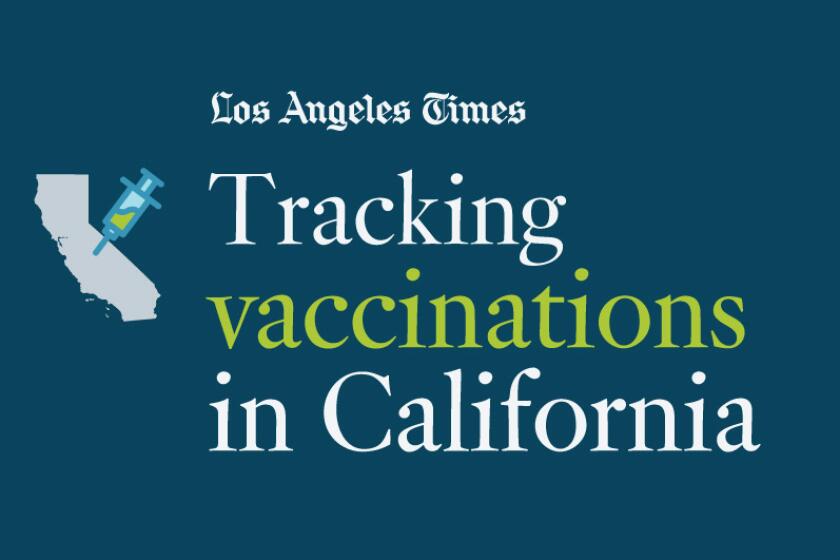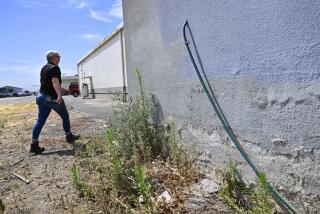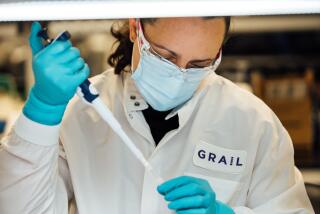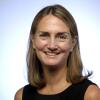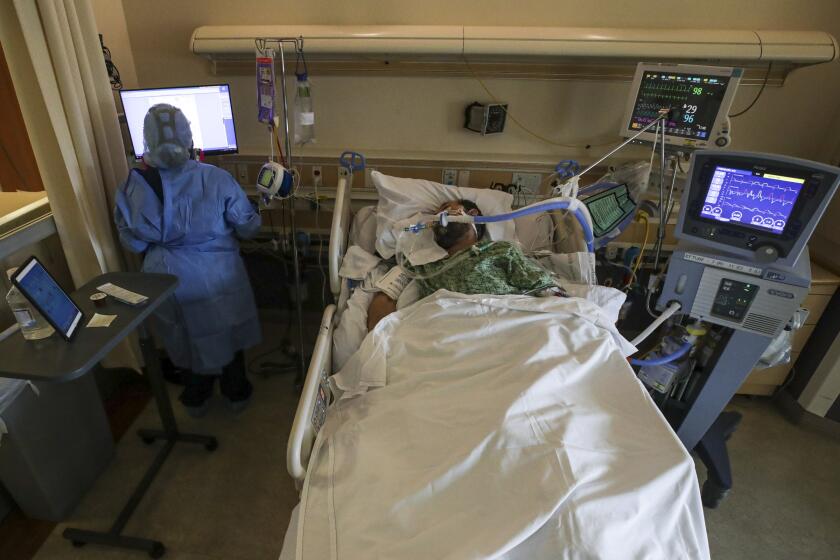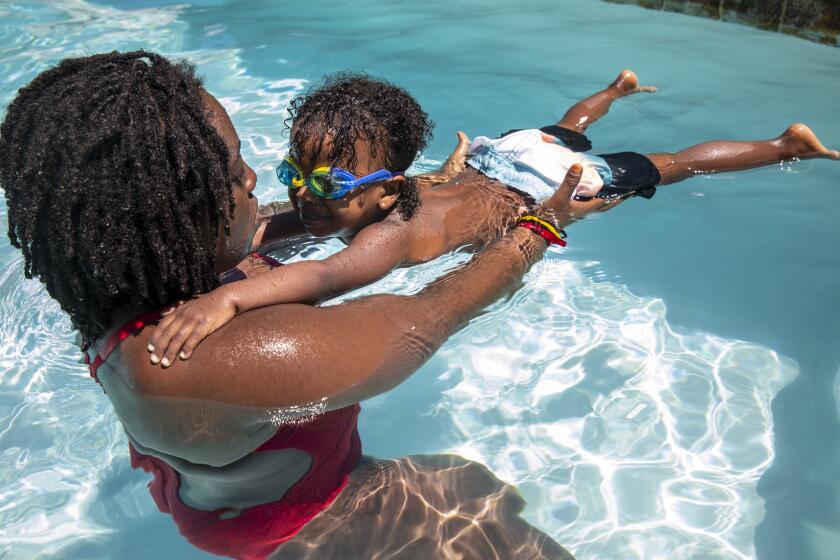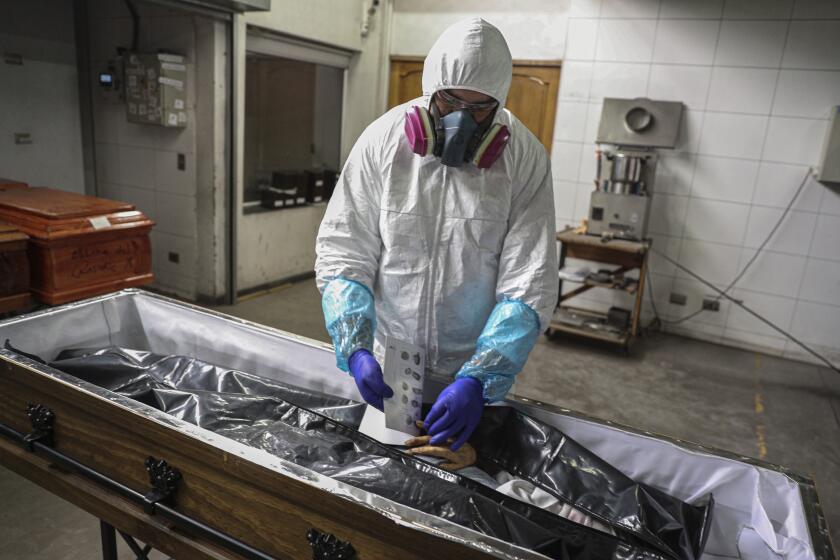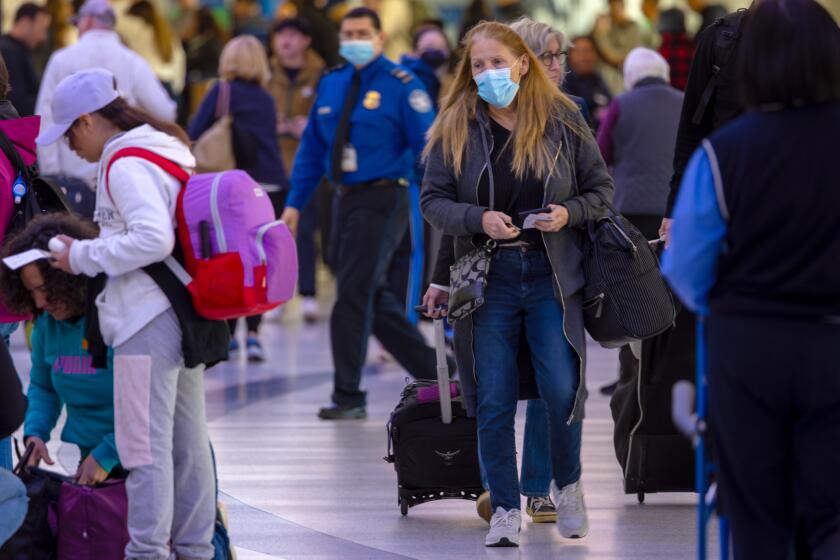
It was a one-two punch that could damage an established company, much less a year-old start-up.
In January, the Food and Drug Administration cautioned that COVID-19 tests made by Curative might inform patients they were free of the virus, even when they weren’t — a so-called false negative that would allow infected people to unwittingly spread the deadly illness.
For the record:
9:50 p.m. March 30, 2021At the time of publication, Curative said that venture capital firm DCVC had participated in an $8.8-million funding round. Curative now says DCVC only participated in an earlier funding round.
The URL of the Florida Bulldog news site is listed in the article as BullDog.com. The URL is FloridaBulldog.org.
Not long after, administrators at a Colorado health system grew skeptical over a string of positive results from Curative and decided to have employees retested by another lab, only to find that the original results were wrong — a so-called false positive, in a healthcare setting where infected patients are kept together, which could expose those who don’t have the virus to those who do.
“It’s scary,” said Yvonne Myers, the system’s director. “You could give them COVID.”
At a time when the standard COVID-19 test relied on a cotton-swab probe deep inside the nostrils, Curative promised accurate results if people would just cough and swab their mouths — an approach that diverged from established science.
Led by Fred Turner — a 25-year-old who dropped out of the University of Oxford to pursue his entrepreneurial dreams — Curative had in a year gone from fewer than a dozen employees to servicing mass testing sites such as Dodger Stadium, conducting more than 17 million COVID-19 tests. It may have grossed $1 billion or more in taxpayer money and insurance premiums.
We came in and filled this void where others couldn’t scale up.
— Fred Turner, Curative CEO
The privately held Los Angeles-area start-up had become California’s latest venture-capital-backed success story, a victor of the coronavirus economy that at one point said it was performing about 10% of all tests administered each week in the U.S. But questions have mounted about its test’s accuracy.
Turner stands by his company’s test and attributes Curative’s rapid growth to its ability to develop a simple diagnostic, build a robust supply chain and process millions of tests as other labs were overwhelmed.
“We came in and filled this void where others couldn’t scale up,” said Turner, the company’s co-founder and chief executive.
Experts say about most Americans will need to be vaccinated to bring the coronavirus pandemic under control. Track California’s progress toward that goal.
In a bid to improve his company’s reputation, Turner has submitted to the FDA results of two clinical studies designed and carried out on his own employees in a matter of weeks. He boasts that they show his test is better than the standard, uncomfortable nasopharynx test backed by the federal agency — though they have yet to be peer-reviewed or published independently.
One year into the pandemic, much of the world has moved on from testing and turned its focus to vaccine supply, including Curative, which is distributing vaccines as it looks to reinvent itself. But the story of how a tiny start-up with an unconventional diagnostic mushroomed into a billion-dollar testing juggernaut illuminates just how unprepared L.A. County, California and the nation were for what was coming. It’s a story rooted in a debilitated public sector that in response to an overwhelming catastrophe opted to relax regulations and place its faith in companies large and small that were ready and able to profit from a once-in-a-century pandemic.
“We didn’t have the public health facilities set up to really take part in helping keep the populations in this country safe,” said Michael Mina, an epidemiologist at the Harvard T. H. Chan School of Public Health. “And so this led to a huge decision to lean heavily on private industry.”
Unexpected opportunity
When COVID-19 arrived, decades of under-investment had prompted the closure of 1 in 4 of California’s public health labs, leaving the state with fewer than one lab per million residents and many with annual equipment budgets of zero dollars. Other states found themselves similarly unable to scale up the massive testing needed to keep the pandemic in check.
Commercial and other labs sprung into action, and the FDA cleared the way for more than 200 COVID-19 tests under its “emergency-use authorization” process. That expedited review allows test developers to begin selling their test as long as they register with the FDA and follow up with limited research showing they “may be effective.”
Many labs began making tests to collect samples from the upper throat, where the pathogens are known to colonize: nasopharyngeal tests, the longtime standard for diagnosing influenza and other respiratory viruses. Reaching the area with a long swab is not only highly unpleasant for the patient but needs to be done by trained medical personnel in protective gear.
Turner thought he had a better idea.

He had been in the San Francisco Bay Area for several years trying to get a start-up off the ground. As a teenager, he had assembled a polymerase chain reaction machine to figure out why he didn’t have red hair like his mother and brother. That same technology is used to detect COVID-19 cases.
The achievement garnered him awards, leading to an unsolicited offer from a farmer to buy the device to genetically test his cows. Turner figured the farmer was on to something and created a company aimed at offering cheap, $15 genetic tests to improve herds.
That company, TL Biolabs, earned him a slot in the famed Mountain View, Calif., accelerator Y Combinator and a Thiel Fellowship, which awarded him $100,000 for dropping out of Oxford to pursue the start-up full time.
The idea didn’t pan out. “You have to basically capture every single cow in the entire U.S. for it to be a billion-dollar business,” Turner came to realize.
TL Biolabs decided to apply its technology to human infections, and Turner continued fundraising, amassingmore than $10 million before the company failed. He had started Curative to continue that work — just as COVID-19 emerged.
Based on data from the 2003 SARS outbreak, Turner concluded that there probably would be a sufficient viral load in oral fluids to detect the coronavirus. By adapting the coronavirus test developed by the Centers for Disease Control and Prevention, Curative in February 2020 created its own prototype.
Because Curative’s test is self-administered — users are told to cough three times and then swab their gums, tongue and other areas inside their mouths for at least 20 seconds — there is no need for medical observers to constantly change out of personal protective equipment, which was in short supply. And although the FDA required trained observers to monitor patients as they perform the test, the agency did not specify that they needed medical certification. So Curative was able to tap cheaper temporary workers, including some with just a high school education, or rely on partners, such as Sean Penn’s nonprofit CORE at Dodger Stadium.
Anticipating huge demand for high-speed testing, the company built up database software, developed a field operation and ensured that its lab could handle the volume.
lnvestors were excited by the test’s potential. Curative raised an additional $1 million from angel investors and Palo Alto venture capital firm DCVC. A few months later, DCVC, Burlingame venture capital firm Refactor Capital and Chris Anderson, the curator of the TED speaker series, led an $8.8-million funding round to scale up the testing, a company spokesperson said.
Anderson said Turner, with his easy-to-administer test and other innovations, had hit upon the same formula for success that he wrote about in a 2013 Fortune cover story on Steve Jobs and Elon Musk — “system-level design thinking” as much as great products.
“That’s what the testing regime needed back in February. It wasn’t great science — the science of what a PCR test looks like was actually known,” Anderson said. “The problem was a matter of logistics. How do you scale up something like that? It’s about figuring out how you manage complex bar-code systems on a spreadsheet. And doing that really fast.”
Though its Bay Area location put Curative at the heart of the world’s venture capital ecosystem, the company was having trouble finding a local lab that met FDA standards to handle human tests, in high demand amid the pandemic. Turner found one in San Dimas through MarsBio, an L.A. biotech venture capital firm where one of his Y Combinator classmates had landed. Turner and his small team relocated to L.A. County in March, working from hotels and Airbnbs as they got the test off the ground.
The move put Curative in proximity to the city government of Los Angeles, which had suspended the normal bidding process in hopes of quickly finding a company that could ramp up mass testing. The city chose Curative, a spokesperson said, because it showed an ability to scale up rapidly, offered a self-administered test and used a local lab so could get results back faster.
By May, cars were lined up hundreds deep in the streets of Elysian Heights as people waited to get a Curative test at Dodger Stadium.
“At the beginning, we thought we were just [going to be] doing a couple of thousand a day, but you know, Fred is very ambitious and said, ‘You know, we need to be building toward a million a week,’” said Isaac Turner (no relation), a company co-founder and chief information officer.
The company used its deal with Los Angeles to open doors across the country. In an online sales brochure, it included a link to a video tweeted by Mayor Eric Garcetti of scores of cars lining up for Curative tests at Dodger Stadium.
Turner also benefited from his venture capital network. Curative joined up with Gothams, a consulting firm founded by a DCVC partner that includes former special operations military officers and aerospace executives. The company soon inked deals to test members of Congress, employees of the Department of Defense and residents of Texas, Alaska, Florida and Delaware.
Subsidized test
Turner had failed to break into the diagnostics industry with TL Biolabs after discovering the market wasn’t suitable for mass cheap testing.
But this time the circumstances were different. The “cheap” part wasn’t a necessity.
The federal government early in the pandemic poured billions into testing. In March, Congress passed the federal CARES Act, requiring health insurers to cover the cost of tests, with no out-of-pocket cost to the patients, which has allowed companies such as Curative to offer the service free.

“You will never receive a bill from Curative for a covid-19 test,” Turner tweeted Jan. 11.
In Los Angeles, the city paid Curative $115 to $150 upfront for each test kit as they were delivered by the thousands every day to Dodger Stadium and other sites across the city, according to invoices reviewed by The Times.
By late June, Los Angeles had paid $62 million to Curative when the city asked the company to begin billing health insurers, a city spokeswoman said. The company billed the city an additional $19.8 million through the end of last year, which included testing for the uninsured. The city is seeking federal reimbursement for all those testing costs, she said.
Currently, Curative bills health insurers $325: $250 for the test and $75 to collect the specimen, according to the company’s website. The company said health insurers and states pay less than the published price, typically about $100 or the Medicare rate for a fast turnaround test.
That kind of pricing across the industry has drawn criticism from public health advocates. Mina figures that the actual cost of an average test run by high throughput labs — which perform hundreds of thousands of mostly automated tests per week — is perhaps $8, plus a “few extra” dollars for overhead.
Turner said labs that may only process tests are an inappropriate comparison to Curative because his company provides its own test kits, has a large field operation and sometimes charters flights to rapidly get samples back to its labs.
“Overall, we’ve already spent more money on the stuff that isn’t the lab test than on the lab test,” he said.
The company declined to discuss its revenue or profits. Turner also declined to break down the costs of the company’s test from the overhead. However, using his $100 reimbursement figure, Curative could have brought in more than $1 billion in revenue from its testing program.
FDA concerns
The FDA granted Curative an emergency-use authorization for its oral fluids test in April but had concerns about the company’s test from the start.
Based on the company’s study data, the FDA required that the test’s administration be closely observed by trained healthcare workers. It also barred Curative from promoting the test’s use for asymptomatic people.
In a medical journal, Turner and his colleagues wrote that the poor performance when its test wasn’t closely overseen by a healthcare worker was unexpected, speculating that some unsupervised patients had not coughed, which could have hindered performance.
The FDA told all labs granted emergency-use authorization that they must not describe their tests as safe or effective as they promote them to customers, doctors and patients, given the truncated review process.
Yet in promotional materials sent to potential customers, Curative describes the test’s “100% specificity” and “90% clinical sensitivity.” A promotional brochure described the test as “exact” and said it had “accuracy greater than peers.”
And for months, until it was changed in late January, Curative’s heavily accessed website said the test was “available to all,” rather than specifying that the FDA had authorized it only for people with symptoms of COVID-19.
Turner defended the company’s marketing, noting that the emergency-use authorization is cited on the website and that Curative recommends that the test be used within its FDA-proscribed limitations. He pointed out that although the FDA regulates the makers of diagnostic tests, it has no power over public health officials who decide how the Curative test is used, including for mass screenings of asymptomatic individuals. And he notes that no coronavirus test is 100% accurate.
Many public health officials, convinced that wide testing was key to keeping the pandemic in check, decided to use Curative’s test beyond its limited emergency-use authorization. In Los Angeles, Chicago and elsewhere, people could get tested even if they didn’t display classic COVID-19 symptoms, such as fever, coughing or lung congestion — often seeking permission slips for work, travel or to see friends and family.
Seeking to expand its FDA authorization, Curative by October had concluded a large clinical study, partially funded by the Defense Department, of 1,300 self-reported asymptomatic people who drove through sites in Los Angeles and San Antonio.
The FDA was not pleased with the results, submitted in December, after conducting its own analysis of the study, according to emails obtained by BullDog.com, a Florida news outlet. Curative and the FDA declined to release the emails to The Times.
An FDA reviewer told the company a few days before Christmas that the agency found that the test did not appear to be accurate even on symptomatic people, much less those without symptoms, according to BullDog. Although Curative provided additional data to the FDA that Turner said disputed the analysis, the agency was unmoved and issued its safety communication.
The FDA statement did not further restrict the test but reiterated that it should be given only to individuals who have had symptoms within 14 days and under the direct observation of trained healthcare providers. It also repeated that any negative Curative test does not rule out a coranavirus infection and that providers should consider giving their patients a different test to confirm results.
“We are warning against false results if these procedures are not followed,” Timothy Stenzel, an FDA official, said during a national conference call soon after the advisory.
The company published a brief response that there had been no changes in “test performance” and that it would continue to work with the FDA to provide “additional data required to address the limitations and precautions.” The response failed to reassure some rattled healthcare providers.

A few days later, L.A. County officials announced that they would switch to another lab. Soon, Curative was dropped by Colorado. Public schools in New Orleans said they had suspended the use of Curative tests while Louisiana officials reviewed their accuracy. Sonoma County health officials quickly warned residents about using a Curative test if they did not have symptoms.
Garcetti, however, stood by the company, keeping the city’s large contract with Curative in place.
“Our customers have largely remained with us and even expanded their relationships in certain cases, such as in the state of Delaware and Riverside County,” a Curative spokeswoman said.
Another blow
Shortly after the FDA’s January warning, the company found it had another problem on its hands: quality control.
Administrators at Columbine Health Systems, which operates nursing homes and other care facilities for older adults in northern Colorado, were surprised when 27 employees at one location tested positive in a single day using Curative. A week later, 17 employees at another facility tested positive.
“We felt in our gut this doesn’t feel right,” said Myers, the director. So the next day, 16 employees were retested by Colorado State University. Fifteen were negative, she said.
False positive results are extremely dangerous in a nursing home, she said, because uninfected residents and employees could be wrongly placed in a unit that cares only for those stricken by the virus.
Colorado officials had required nursing homes and other facilities to use Curative’s tests since the summer. By January, Curative was processing 70,000 tests in the state each week. Shortly after Myers got state approval to use another lab, state officials told other facilities across Colorado to stop using Curative. They did not mention the problems at Columbine but instead cited the FDA advisory.
In over 16 million tests, you’re going to have some percentage of errors.
— Fred Turner
A Curative spokesperson said the Columbine results were “an extremely isolated case of human error with a lab technician” and that the company had experienced such problems with only 0.02% of its results last year.
“In over 16 million tests, you’re going to have some percentage of errors,” Turner said this year.
Rapid studies
After reviewing the published science, the FDA and the CDC have said the nasopharyngeal swab is the best at finding those infected. In interviews, Turner repeatedly said he believes his oral swab is accurate and that it is better than the nasopharyngeal swab.
To prove that regulators were wrong, he got to work on saving his empire by designing and carrying out two clinical studies in weeks — an undertaking that typically takes months or even years.
Curative had been testing its own employees and those of certain vendors daily as a safety measure. That made it possible to pinpoint when some got sick with COVID-19, allowing the company to conduct separate studies on those who had been recently ill and those who were infected earlier.

Results submitted to the FDA, the company said, support the hypothesis that its test accurately catches both symptomatic and asymptomatic people in the early stages when they are infectious, while the nasopharyngeal test produces more positives later, because it picks up people shedding small amounts of virus when they are no longer infectious.
Turner said the results explain how Curative’s test did not previously perform to the FDA’s satisfaction — and why it challenges the consensus that the nasopharyngeal test should be the gold standard COVID-19 diagnostic.
That theory has some support in the scientific community, including by Mina, who says oral fluids are better at telling people when they are actually infectious. Turner also notes that the CDC advises people that they can test positive for COVID-19 months after the illness has passed.
The results were heralded by some Curative advocates, such as Rick Pescatore, chief physician of the Delaware Department of Health, which expanded its partnership with the company despite the FDA advisory.
He tweeted that the company had a “Big data release that shows how @Curative‘s #COVID19 testing platform not only stacks up to but likely outperforms nasopharyngeal samples.”
The positive reception has not been universal for the company study, which more than two months later has not been published in a peer-reviewed journal.
Geoffrey Baird, a professor of lab medicine and pathology at the University of Washington, who reviewed the company’s FDA submission, disagreed with Curative’s theory that the patients with low viral loads picked up by a nasopharyngeal swab were all no longer infectious.
“I’m still concerned that the overall approach of doing oral fluid testing lacks sufficient sensitivity and probably will be missing people who are infected,” Baird said, noting that scientists have yet to determine the low threshold at which patients won’t spread the virus.
He said Curative had not provided enough information in its filing with the FDA for him to understand why its oral fluids test would suddenly compare favorably to the nasopharyngeal swab — a sharp change from earlier trials.
“There’s obviously an enormous amount of money at stake here,” Baird said. “Is there any secondary gain from continuing to push a test that may not have the best clinical sensitivity? I think the answer has to be yes.”
Uncertain future
Unlike most venture-capital-backed start-ups, Curative found customers and revenue fast — but its future is as uncertain as the virus’ next mutation.
Last April, when the FDA awarded Curative its authorization for emergency use, the start-up’s easy-to-administer oral fluid test filled a void. But now there’s competition from scores of companies and a lower demand for tests. Public health departments spooked by the FDA’s safety communication had no trouble finding replacements.
Curative’s greatest achievement, by its own admission, was in the rapid administration and processing of tests and the distribution of results.
“We don’t do anything magical,” Turner said. “Really there’s no new scientific advances that we’ve come up with. We took the CDC test and got really good running it at scale.”
Curative is now putting that expertise to use distributing vaccines in five states, but that’s a fraction of the footprint it had for its tests — and is yet another service with a limited shelf life. Turner said the company is working on other projects in healthcare and diagnostics, though he declined to provide details.
The outcome of those efforts will determine whether Curative was just a flash in the pan that took advantage of an extraordinary confluence of reduced regulations, a desperate public sector and plentiful government funding — or whether it can create a long-lasting business.
Turner’s investors continue to stand by him; one called him a “lab rat” and said it was a “no-brainer” to financially back him. Turner, himself, still holds out hope that the government determines that it was inappropriate to compare his company’s test against the nasopharyngeal swab.
“People don’t like to go back and admit that maybe that was not a correct decision,” Turner said, expressing frustration over the issue.
He’s not likely to get the last word in that debate, though.
The FDA could reconsider its safety advisory on the novel COVID-19 test that Curative has ridden to fame, fortune and, now, a share of notoriety — or simply leave it in place.
